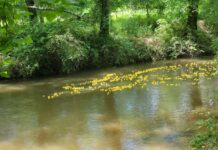
From a distance, it might look like any other ant. But the Asian needle ant is unique, and you won’t see them marching in a line up a tree.
According to University of Georgia Orkin Entomologist Dr. Dan Suiter, these ants travel alone. Their venomous bite can result in a simple sting or, in some people, more serious problems.
Comparing their sting to that of a fire ant, he said, “Last year, I fielded three questions from homeowners who suffered anaphylactic shock from being stung by this ant.” Suiter said he’s only heard from one person bitten by a fire ant who suffered similar side effects in his 25-year career, although fire ant stings certainly can cause adverse injuries.
Not all people who get stung will go into shock, but the stings are painful, and as soon as they fade, the pain can return. Suiter said you can prevent ant bites by keeping lawns clear of debris or using preventative pest control treatments.
Beyond the sting
Beyond the Asian needle ant’s painful sting, extension agents say it also can infest homes and devastate natural environments by eliminating native ant species and termites.
“Our native ants play essential roles in maintaining the status quo of the forest ecosystem and Asian needle ants either directly eat them, consume their food, or take over their nest sites,” according to the North Carolina State University Extension Service.
When the Asian needle ant eliminates the native species or reduces their abundance, it impacts activities such as seed dispersal and natural pest control.
How to identify the species
Asian needle ants are relatively long and slender, dark brown to black in color, with legs and mandibles that are lighter brown to orange-ish.
These ants can also be distinguished from others because they can’t cling to smooth surfaces like glass. Put them in a jar, and you’ll see that after several failed attempts, they confine themselves to the base of the jar.
The Asian needle ant prefers to nest in moist, damp areas like the insides of rotting logs, leaf litter, beneath rocks, and in loose soil, but will also nest in man-made structures, like around sprinkler systems and inside pavement crevices. Colonies can range from several dozen to thousands of ants.
At present, there is no formalized management recommendation for Asian needle ants. However, they do respond to protein-based insecticide baits.
The NC State Extension Service says professional products such as Extinguish Plus®, Advion® Fire Ant Bait, Optigard®, and Maxforce FG® are suitable baits for Asian needle ants. For homeowners, fire ant baits such as “Amdro” should work.
“It is important to think in terms of management rather than eradication,” the agency says.
Dr. Suiter adds, if you find an ant you need to identify, contact your county extension agent.
Chase McGee of GPB News contributed to this article







